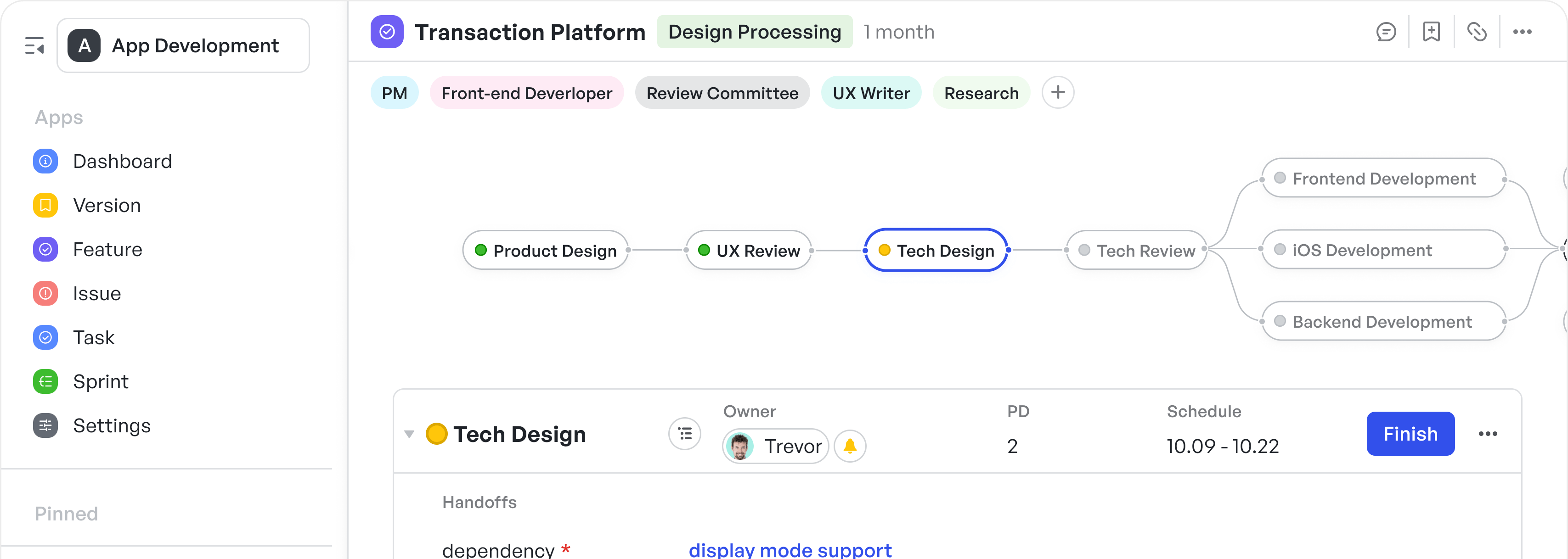How to Write a Product Charter: Step-By-Step Guide

Creating a product charter can feel overwhelming, especially if it's your first time. You're expected to distill complex project details into a concise document, all while securing stakeholder buy-in based on how you present it. What should you include? Where do you even start?
Help is here!
This guide breaks down a real-world product charter into 15 clear, practical steps. It also includes a free PDF of a sample project charter to streamline your product development process. Everything you need to create a focused, strategic charter (and the tool to turn it into an actionable plan) is right here.
What is a product charter?
A product charter is a short strategic document that defines your product's purpose, goals, scope, key stakeholders, and success metrics. It helps product managers secure buy-in, prevent scope creep, and maintain strategic focus throughout the product lifecycle from day one.
What will you get?
- 2 fill-in-the-blank, Meegle project charter templates
- 1 sample project charter PDF
- A proven 15-step framework
- A real-world example to guide you
Your winning product charter outline
It includes all the key components of a product charter, like objectives, stakeholders, and success metrics.
| Section | Project Charter Components |
|---|---|
| 1. Product overview | What the product is and why it matters now |
| 2. Product sponsor | Who's funding and championing the initiative |
| 3. Purpose/Justification | The business case and strategic rationale |
| 4. Project charter objectives | 2–3 SMART goals that define success |
| 5. Product scope | What's in, what's out, and what's expected |
| 6. High-level requirements | Must-have features, functions, and constraints |
| 7. Stakeholders | Key people or teams impacted or involved |
| 8. Timeline | Major phases and milestones |
| 9. Budget estimate | Rough cost breakdown (if known) |
| 10. Success criteria | How you'll measure if the product works |
| 11. Assumptions and constraints | Known limits or things taken as givens |
| 12. High-level risks | What might go wrong or delay progress |
| 13. Roles and responsibilities | Who owns what across the team |
| 14. Communication plan | How updates will be shared and with whom |
| 15. Sponsor approval | Final sign-off to begin execution |
Sneak peek at the templates
1. Product charter template for lean projects
 Lean project charter template
Lean project charter template2. Project charters for generative AI technologies
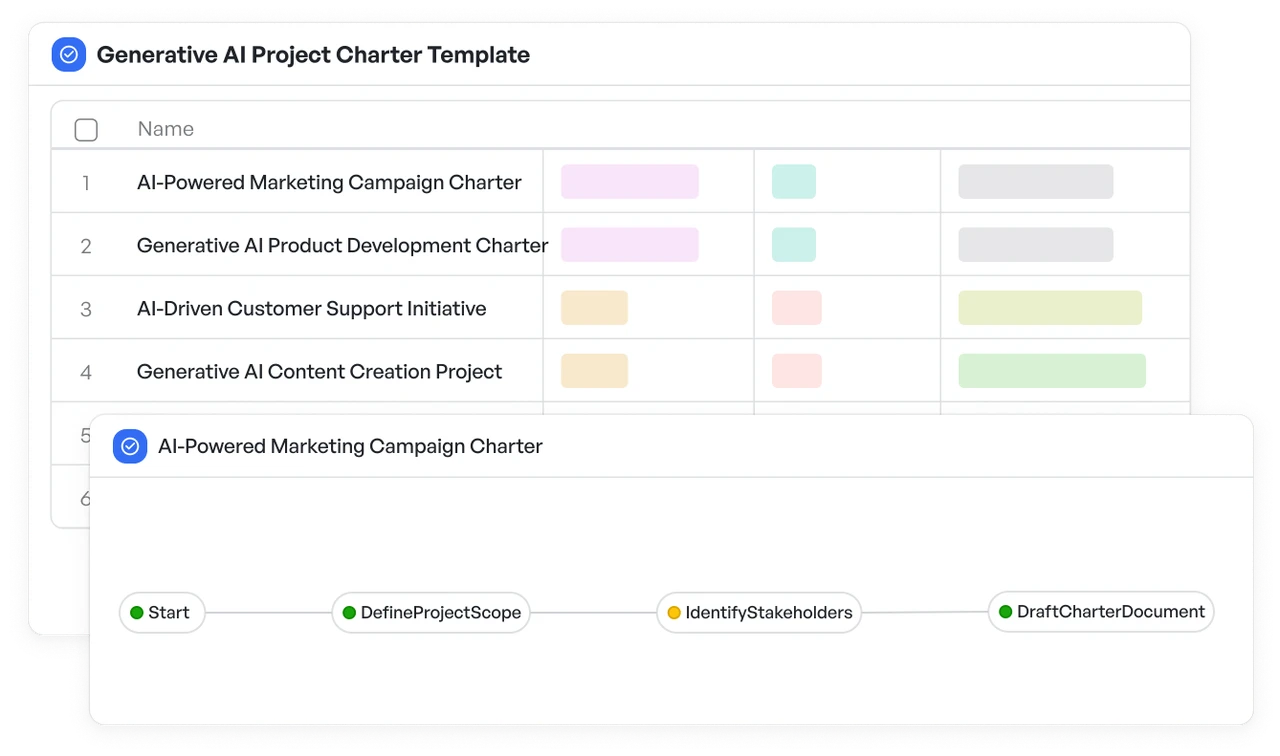 Generative AI project charter template
Generative AI project charter templateDo you need a product charter?
In this Reddit thread, a project manager posed a question, sparking split responses:
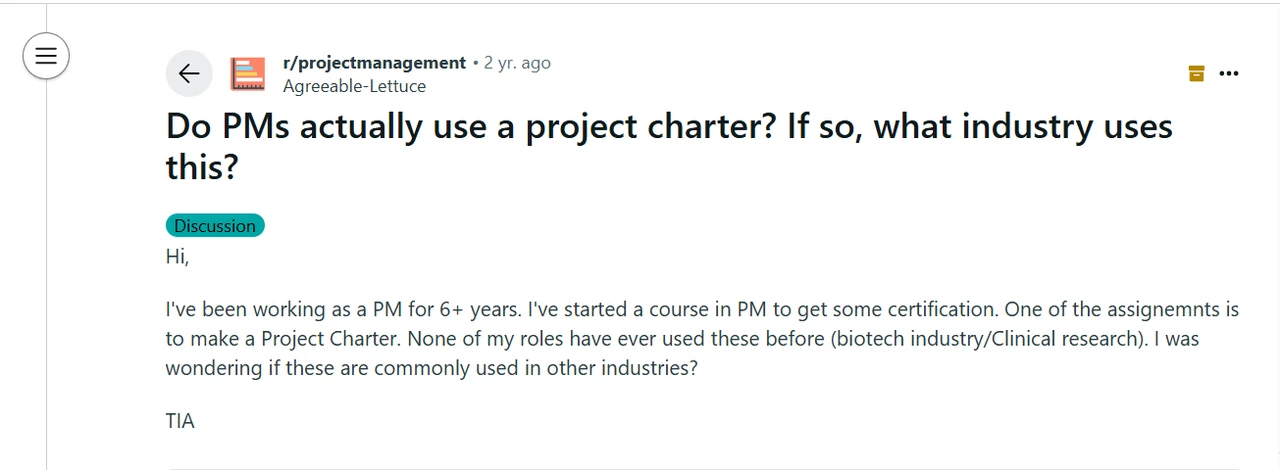 Do you need a project charter? (Source: Reddit)
Do you need a project charter? (Source: Reddit)- For some teams, a charter is non-negotiable. No charter, no project:
 No charter, no project (Source: Reddit)
No charter, no project (Source: Reddit) - Others said they kicked off without anything formally called a "charter":
 Formal charter needed (Source: Reddit)
Formal charter needed (Source: Reddit)
Here's the twist:
A charter doesn't have to be one formal document. It might live across several files, like briefs, project proposals, or discovery summaries. And anyone can create it.
Bottom line:
You need a product or project charter to kick off initiatives successfully. It aligns teams early and defines your mandate.
Importance of a product charter
Here are three benefits of product charters, specifically for product managers:
- Clear roadmap: A product charter forces early alignment on scope, goals, and success metrics, so you're not chasing a moving target mid-project.
- Faster stakeholder buy-in: When stakeholders see a structured plan with risks, timelines, and objectives outlined, they're more likely to commit.
- Reduced scope creep: A well-defined charter sets boundaries for what's in and out of scope. This helps you manage expectations and push back when new requests threaten to derail timelines.
Product plan vs. product charter: Are they the same?
No.
- A product plan is tactical. It maps out how you'll execute the features, timelines, and releases.
- A product charter is strategic. It answers: what are you building, why now, and how will you define success?
Detailed comparison:
| Product Charter | Product Plan | |
|---|---|---|
| Purpose | Define vision and align stakeholders | Guide execution of product development |
| Focus | Strategy, goals, scope, key players, success | Features, milestones, delivery timelines |
| Created by | Product lead or project sponsor | Product manager or product team |
| Timing | At project kickoff | After strategic alignment is secured |
Whether it's your responsibility or a request from leadership, below is how to write a product charter that gets buy-in.
You can read more about product planning in this blog: 👉Visual Product Planning: A Step-by-Step Success Guide
15 Steps to Write a Product Charter
To make this concrete, let's walk through the process of writing a product charter—step by step—using an example: a productivity app for remote teams.
Haven't downloaded the product charter template and sample yet?
Grab them now:
Step 1: Clarify the project request
Who's responsible: The product manager or project lead typically owns this step.
What they do: They gather context for the request—what the project is, who initiated it, and why it matters now.
For a remote team productivity app, this means identifying the business problem (e.g., fragmented workflows, async misalignment) and confirming that the request is for a cross-platform MVP (Minimum Viable Product) for iOS and Android.
| Do's: | Don'ts: |
|---|---|
| * Interview the requester, | * Assume the request is straightforward, or |
| * Validate the problem, and | * Accept feature lists without context. |
| * Summarize the request in plain language. |
Entry in the sample charter (Section 1 – Project Overview):
This project will deliver a cross-platform MVP of a productivity app for remote teams. The goal is to improve task clarity, async updates, and lightweight collaboration in distributed work environments.
Step 2: Identify the project sponsor
Who's responsible: The project manager or product lead identifies and documents the project sponsor.
What they do: The sponsor is the executive champion, like the Chief Product Officer, who authorizes the project, funds the effort, and clears roadblocks. They're accountable for strategic alignment and often have final approval over scope and budget.
| Do's: | Don'ts: |
|---|---|
| * Confirm the sponsor's name, role, and level of involvement. | * Leave this section blank or assume the sponsor will stay engaged throughout without prompting. |
| * Book a kickoff check-in if possible. |
Entry in the sample charter (Section 2 – Project Sponsor):
[Name], Chief Product Officer, owns the product development budget and provides strategic oversight.
Step 3: Define the project purpose/justification
Who's responsible: The product manager, in collaboration with the project sponsor.
What they do: This section explains why the project exists and what business value it delivers. For a remote team productivity app, the purpose might be to reduce tool overload, improve async collaboration, and support hybrid workflows—all aligned with company strategy.
| Do's: | Don'ts: |
|---|---|
| * Link the purpose to a specific business need, strategic goal, or customer pain point. | * Use vague phrases like "drive innovation" without tying them to measurable outcomes. |
Entry in the sample charter (Section 3 – Purpose/Justification): This app will help remote teams reduce miscommunication and context-switching by centralizing task updates and async check-ins, leading to faster execution and improved team visibility.
Step 4: Set the project charter objectives
Who's responsible: The product manager, with input from the project sponsor and relevant stakeholders (e.g., design, engineering, operations).
What they do: Define 2–3 measurable objectives that represent what success looks like. Objectives should tie directly to the problem and value outlined in the charter.
You can use the Node forms in Meegle's project charter template to define project objectives, link them to specific goals, assign owners, and set priorities and deadlines—all in one place.
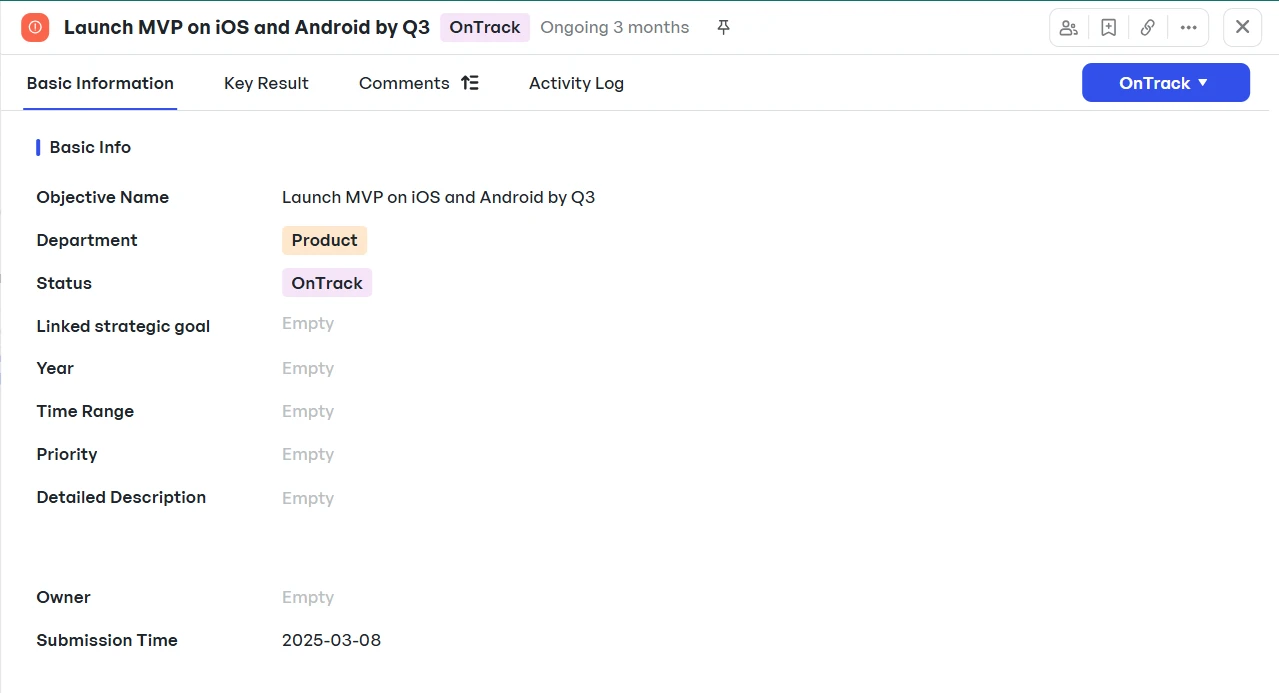 Using Meegle to set project objectives
Using Meegle to set project objectives| Do's: | Don'ts: |
|---|---|
| * Use SMART objectives—Specific, Measurable, Achievable, Relevant, and Time-bound. | * List vague goals like "build a great app" or "launch quickly" without defining what that means. |
Further reading on setting project management goals!
Entry in the sample charter (Section 4 – Project Objectives):1) Launch MVP on iOS and Android by Q3 2) Achieve 70% weekly active usage by pilot teams 3) Reduce async status update time by 30% in target teams
Step 5: Outline the project scope
Who's responsible: The product manager, with input from engineering and design leads.
What they do: Define what the MVP will and won't include. This way, you will manage expectations and prevent scope creep.
| Do's: | Don'ts: |
|---|---|
| * Be specific—include key features, platforms, and integrations. | * Leave scope open-ended or assume "everyone knows what's in." |
Further reading on setting project scope!
Entry in the sample charter (Section 5 – Project Scope):- In scope: MVP features include task creation, status updates, @mentions, and async check-ins for iOS and Android.- Out of scope: Calendar integration, web dashboard, and team analytics.
Step 6: List high-level requirements
Who's responsible: The product manager, supported by design, engineering, and QA leads.
What they do: Capture the critical capabilities the MVP must support. These aren't detailed user stories yet—only key functions or technical considerations. Think of them as non-negotiables for success.
| Do's: | Don'ts: |
|---|---|
| * Include UX, technical, security, and platform-specific needs. | * Overload this section with low-level details or backlog items. |
Entry in the sample charter (Section 6 – High-Level Requirements):1) Users must be able to create, assign, and update tasks 2) The app must support offline access and sync when reconnected 3) Must meet SOC 2 standards for data security
Step 7: Identify key stakeholders
Who's responsible: The product manager or project lead.
What they do: List individuals or teams with vested interests in the project's success and whose work the outcome will affect.
Each Meegle project charter template includes built-in roles & teams features. You can use them to assign stakeholder roles and ensure they receive automated updates on deliverables and project progress.
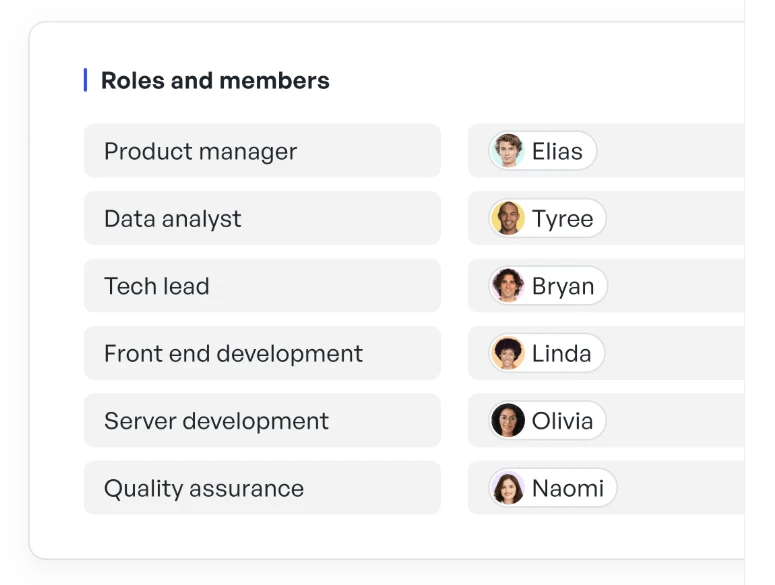 Assigning roles on Meegle
Assigning roles on Meegle| Do's: | Don'ts: |
|---|---|
| * Include names, roles, and what aspect of the project they influence. | * Assume stakeholders will stay aligned without intentional communication. |
Entry in the sample charter (Section 7 – Stakeholders):
| Name | Role | Interest / Influence |
|---|---|---|
| [Name] | Chief Product Officer | Sponsor and strategic lead |
| [Name] | Head of Engineering | Development resourcing and timeline oversight |
| [Name] | UX Lead | User research and MVP design decisions |
| Operations Team | Pilot testers | Provide async workflow feedback |
Step 8: Create a high-level timeline
Who's responsible: The project manager, with input from product, engineering, and design leads.
What they do: Outline vital project phases and milestones, without getting into detailed sprint planning. By doing so, you'll set expectations and give leadership visibility into key delivery points.
For centralized task visibility and resource allocation, teams can use Meegle's Member Schedule.
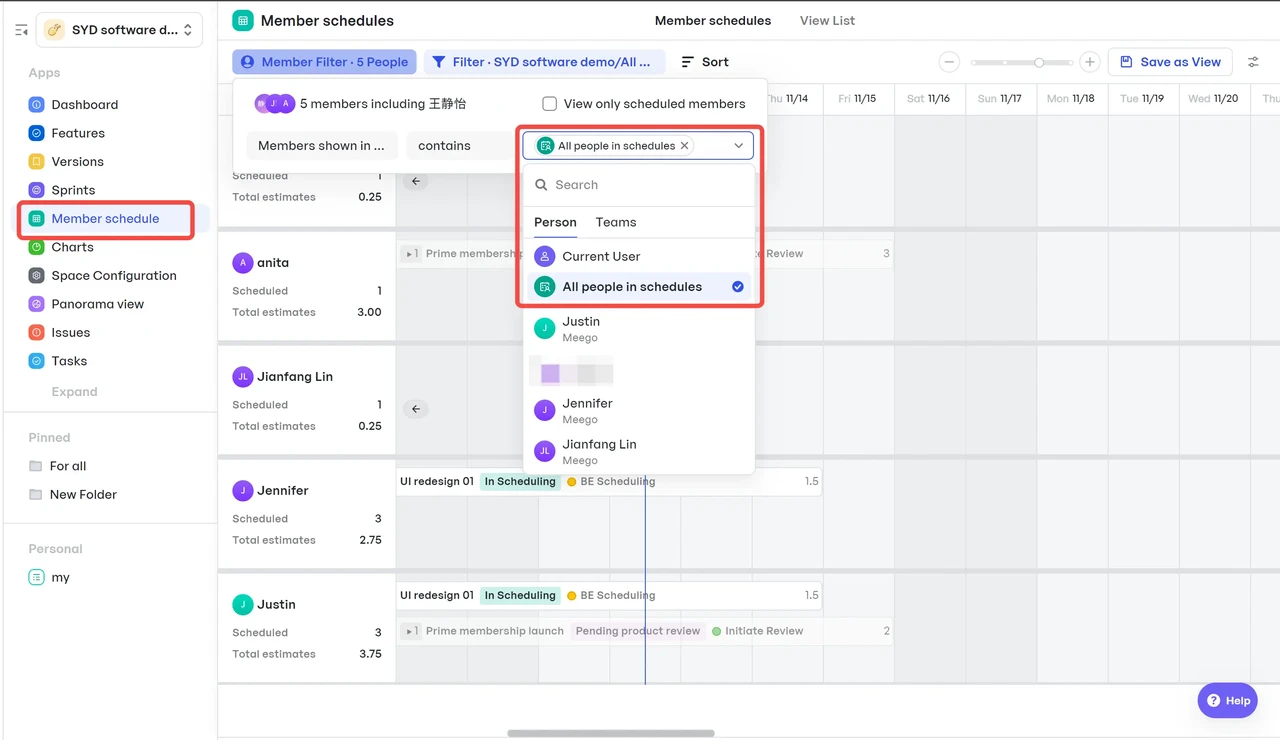 Tracking deliverables and resources on Meegle
Tracking deliverables and resources on Meegle| Do's: | Don'ts: |
|---|---|
| * Include target dates for discovery, design, MVP launch, and pilot testing. | * Add granular tasks or fixed deadlines without cross-functional input. |
Entry in the sample charter (Section 8 – Timeline):- June – Research + wireframes- July – MVP development (iOS + Android)- August – Internal testing + pilot launch- September – Post-pilot feedback and iteration planning
Step 9: Estimate the budget (if known)
Who's responsible: The project manager and the finance or budget owner.
What they do: Provide a rough budget estimate covering development, design, marketing, and any third-party tools or licenses.
| Do's: | Don'ts: |
|---|---|
| * Include critical cost categories and contingencies for unforeseen expenses. | * Wait for exact numbers—initial estimates are sufficient at this stage. |
Entry in the sample charter (Section 9 – Budget Estimate): Estimated $250,000 covering development (60%), design (20%), marketing (10%), and tools/licenses (10%). Contingency fund of 10% included.
Step 10: Define success criteria
Who's responsible: The product manager, collaborating with the project sponsor and key stakeholders.
What they do: Establish measurable indicators that define what success looks like for the project.
| Do's: | Don'ts: |
|---|---|
| * Use clear, quantitative metrics like user adoption rates, engagement levels, or revenue targets. | * Rely solely on vague goals like "customer satisfaction" without measurable benchmarks. |
Meegle charts allow customized indicators. You can use them to track success metrics and generate reports.
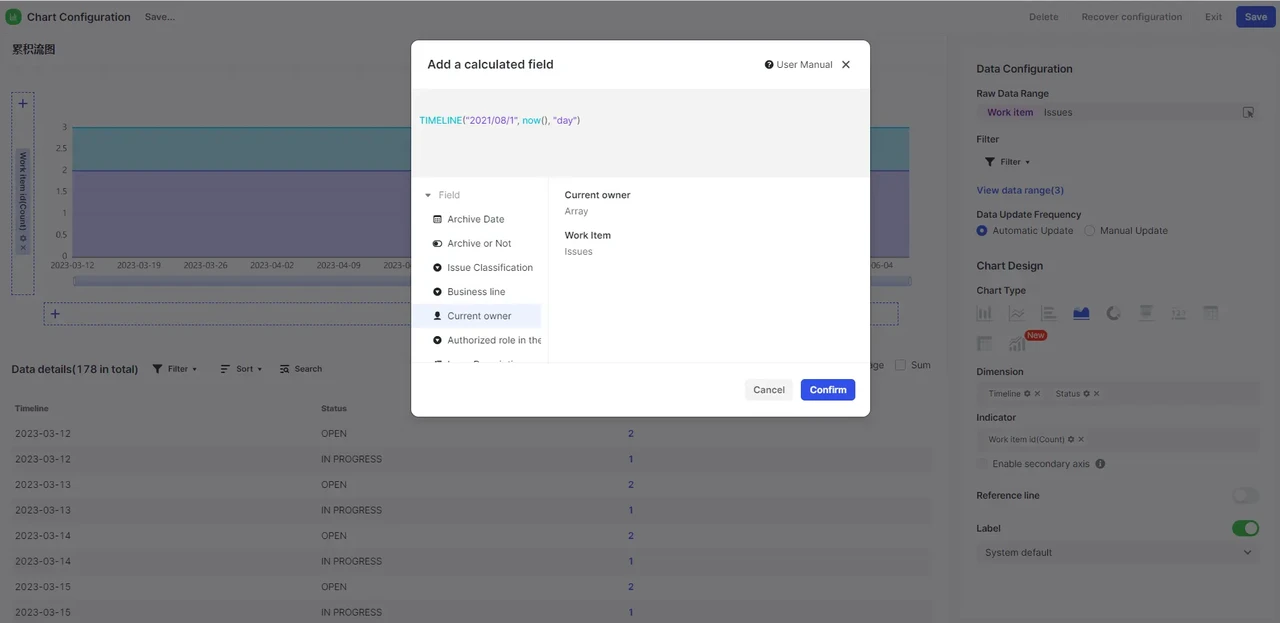 Customizing dimensions and indicators on Meegle Charts
Customizing dimensions and indicators on Meegle ChartsEntry in the sample charter (Section 10 – Success Criteria):1) Achieve a 70% weekly active user rate within 3 months 2) Reduce task completion time by 25% for pilot teams 3) Receive a Net Promoter Score (NPS) of 50+ in initial surveys
Step 11: List assumptions and constraints
Who's responsible: The product and project manager, with input from engineering, design, and stakeholders.
What they do: Document what the team assumes as a fact and any known limitations that could impact the project.
| Do's: | Don'ts: |
|---|---|
| * Be honest about dependencies, unknowns, and blockers. | * Skip this step—it helps prevent surprises down the line. |
Entry in the sample charter (Section 11 – Assumptions and Constraints):- Assumptions: Pilot teams are available for testing; users have mobile access.- Constraints: Mobile-only MVP; limited design capacity in Q2; must meet internal security standards.
Step 12: Identify risks at a high level
Who's responsible: The project manager, with input from product, engineering, and design leads.
What they do: Outline potential risks that could delay the project timeline, scope, or success.
Meegle's dedicated Risk tabs let you log project risks, define attributes and likelihood, and outline mitigation plans. You can easily add them to your project charter workflow to keep risk management organized and visible.
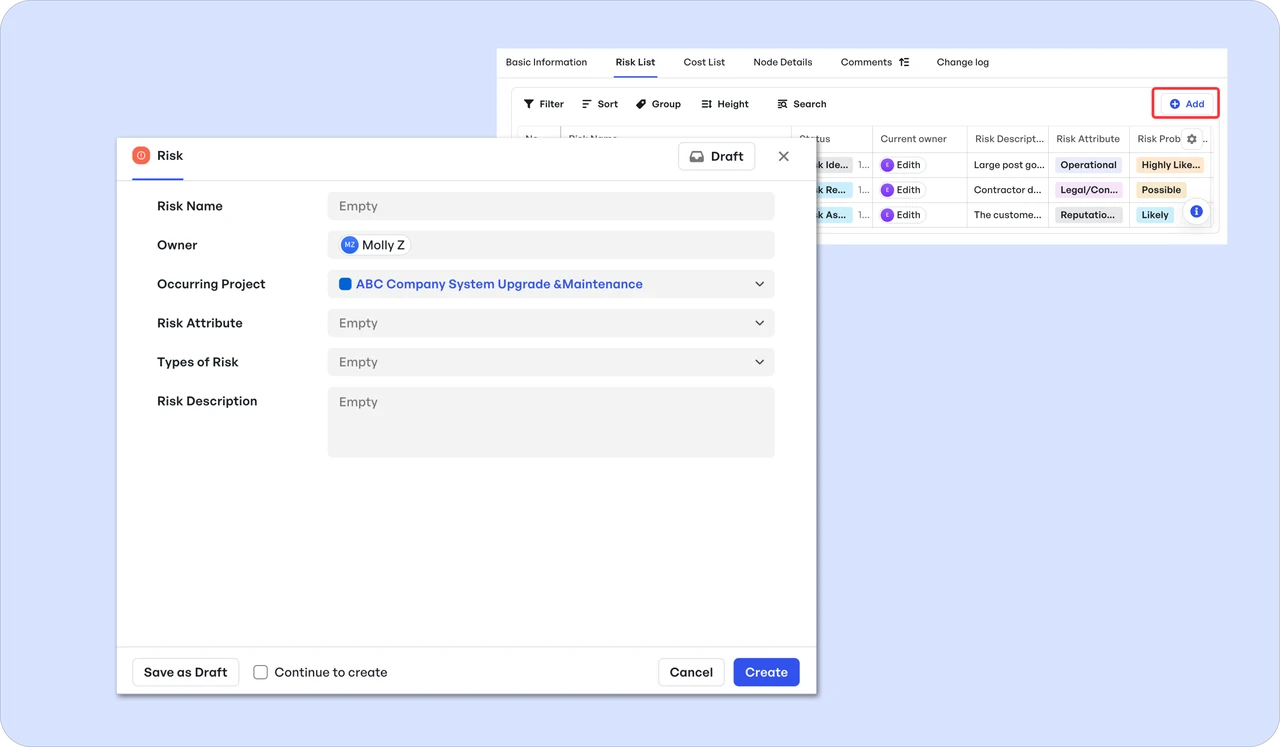 Meegle's Risk tabs
Meegle's Risk tabs| Do's: | Don'ts: |
|---|---|
| * Include risks tied to resources, dependencies, tech feasibility, or adoption. | * Downplay or ignore known challenges to "keep momentum." |
Entry in the sample charter (Section 12 – High-Level Risks):
| Risk | Impact | Mitigation |
|---|---|---|
| Engineering resourcing may shift due to competing priorities | Delays in development milestones or missed launch targets | Confirm resource commitments early and set weekly check-ins with engineering leads |
| App store approval could delay the mobile launch | Postponed MVP release and pilot testing | Submit early for approval; follow platform guidelines closely |
| Remote teams may be slow to adopt new workflows | Low engagement during pilot; poor user feedback | Provide onboarding guides, async demos, and incentives for pilot users |
Step 13: Define roles and responsibilities
Who's responsible: The project manager, with input from team leads and HR if needed.
What they do: Clearly outline who owns what throughout the project lifecycle.
| Do's: | Don'ts: |
|---|---|
| * Specify key roles and responsibilities, avoid overlaps, and confirm everyone understands their scope. | * Leave roles vague or assume team members will naturally know what to do. |
Entry in the sample charter (Section 13 – Roles and Responsibilities):
| Role | Name | Responsibility |
|---|---|---|
| Product Manager | "You" | Project planning, communication |
| Engineering Lead | [Name] | Development execution |
| UX Lead | [Name] | User experience and design |
| QA Lead | [Name] | Testing and quality assurance |
Step 14: Draft a communication plan
Who's responsible: The project manager, working closely with communication or stakeholder leads.
What they do: Decide how, when, and to whom the team will communicate project updates.
| Do's: | Don'ts: |
|---|---|
| * Specify update frequency, formats (e.g., Slack, email, meetings), and target audiences. | * Overwhelm stakeholders with unnecessary updates or leave communication ad hoc. |
Entry in the sample charter (Section 14 – Communication Plan):
| Update type | Frequency | Format | Audience |
|---|---|---|---|
| Status update | Weekly | Slack | Project team |
| Steering committee report | Monthly | Exec sponsors |
Step 15: Get sponsor approval
Who's responsible: The project manager initiates the approval process; the project sponsor grants final sign-off.
What they do: They present the completed product charter to the sponsor for review and official approval.
| Do's: | Don'ts: |
|---|---|
| * Provide clear documentation, highlight key points, and address any sponsor concerns | * Skip this step or proceed without explicit approval—it risks misalignment and wasted effort. |
Entry in the sample charter (Section 15 – Sponsor Approval): Approved by: [Name], Chief Product Officer Date: [Insert Date]
The final charter, using our example:
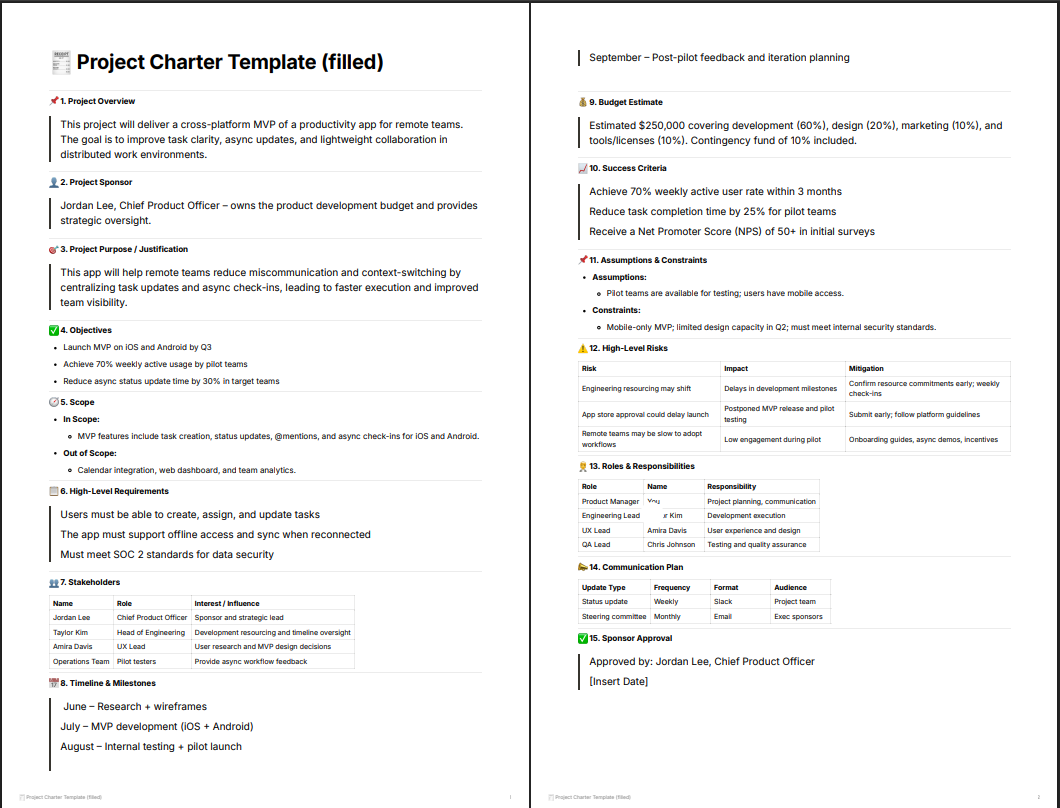 Completed product charter
Completed product charterProduct charter examples: The good and bad
To give you a quiz-like experience, we won't tell you which charter is good or bad until you've seen both.
Product charter example 1:
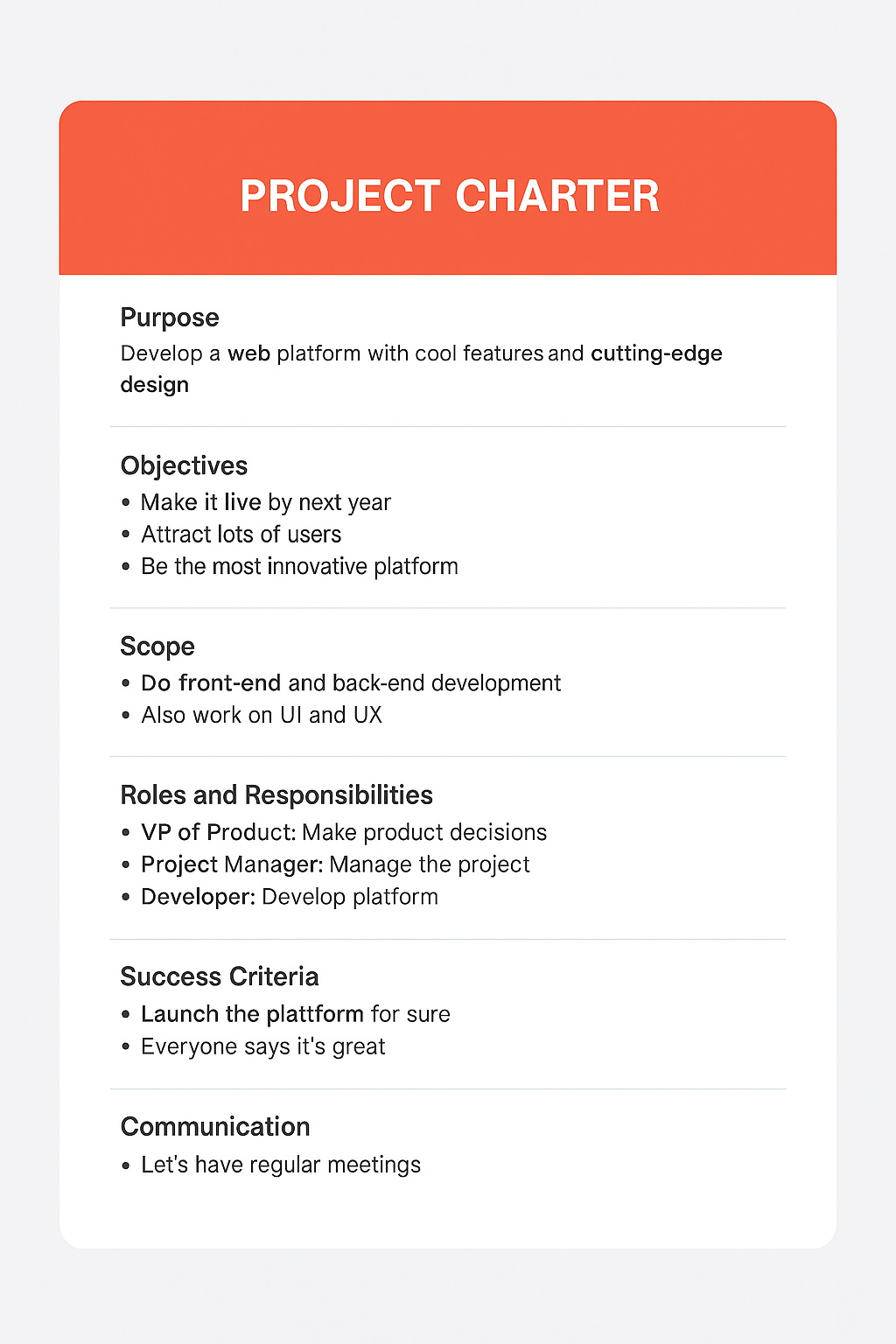 Product team charter example 1
Product team charter example 1Product charter example 2:
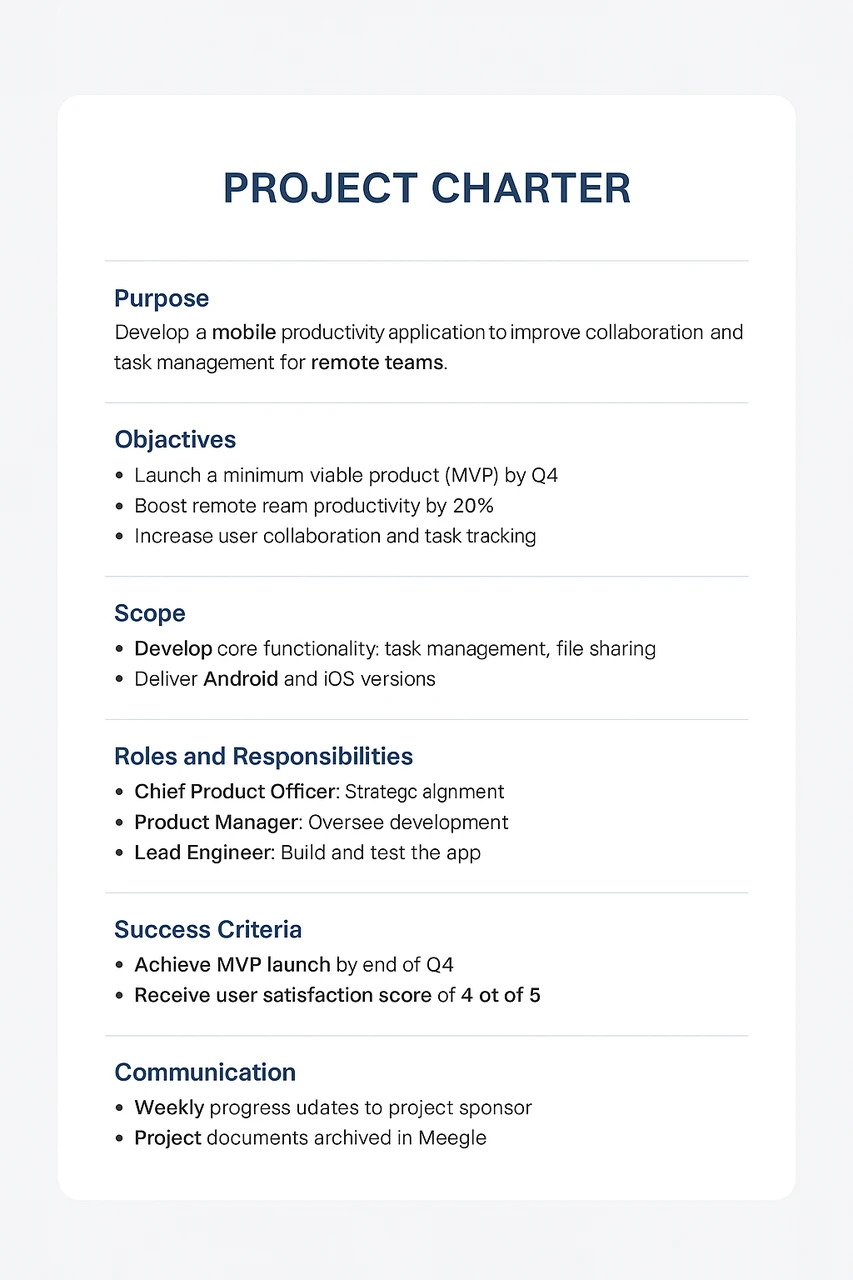 Product team charter example 2
Product team charter example 2Which of these examples is good or bad?
If you said no. 1 is bad and no. 2 is good, you're spot on. You can already recognize a strong product charter, and you'll be able to write one just as easily.
Why?- Example 1 is bad because it's full of buzzwords and lacks clear goals or success metrics.- Example 2 is good because it's focused, measurable, and aligns teams from day one.
Now, you've learned that a charter helps you launch with clarity—and you can create one. What comes next? An execution plan!
How to turn your product charter into a plan
To drive business goals forward, your charter must evolve into a collaborative project plan. In essence, you must connect tasks to objectives, clarify responsibilities, and align teams from initiation to closure.
You can do all that in Meegle's visual workflows, shared dashboards, and real-time updates.
The shortcut? Use the Project Life Cycle template.
Here's how to turn your product charter into an actionable, team-friendly plan in four steps:
1. Upload your product charter
Start by creating your charter using one of Meegle's templates. Then upload it directly into your workflow using Node Forms. This way, everyone in your team has access from the start.
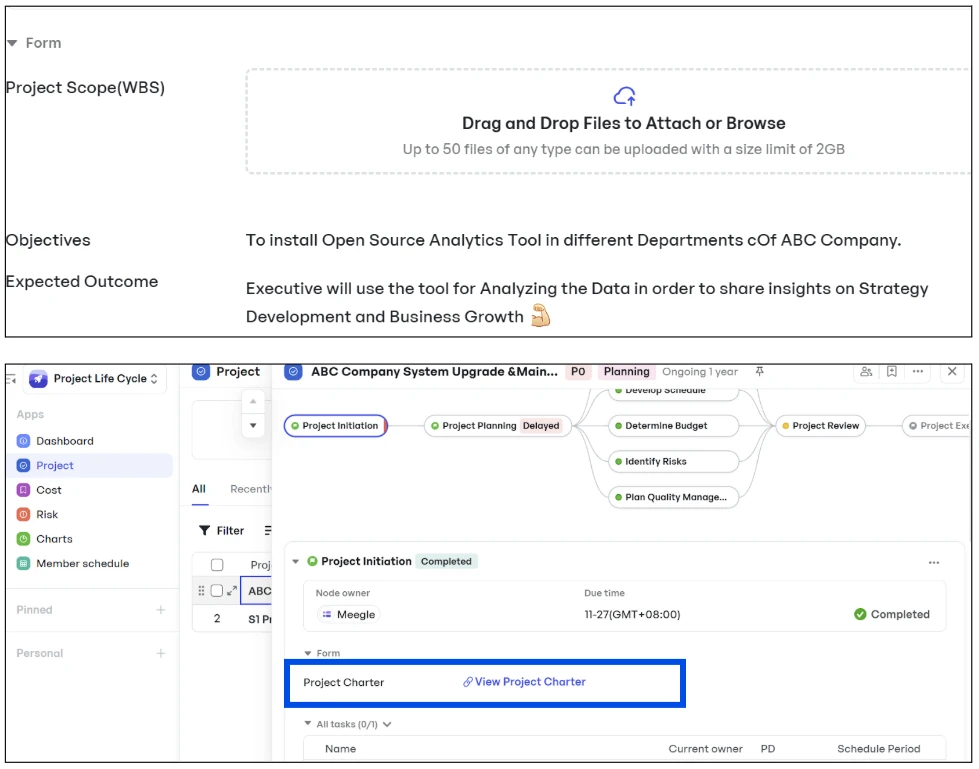 Adding charter to your project management workflow
Adding charter to your project management workflow2. Link tasks to shared objectives
The template includes customizable task and objective forms. Use them to align daily work with business goals. Team members can comment, update fields, and tag each other as they collaborate on tasks.
3. Assign stakeholders and keep them accountable
Meegle's scheduling tools let you assign owners, set due dates, and define dependencies—all visible to the team. Automated reminders and @mentions keep conversations and accountability in one place.
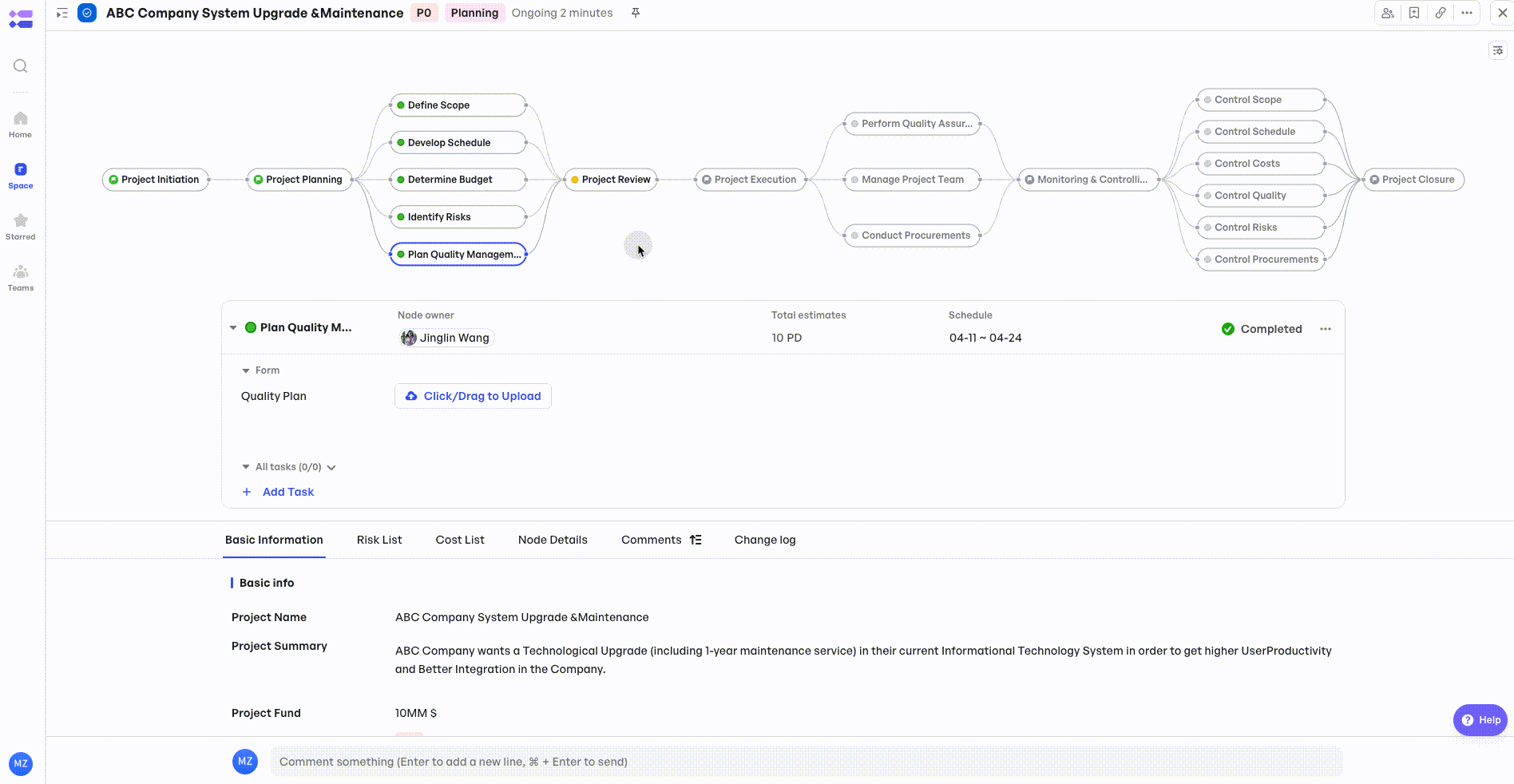 Assigning project stakeholders to tasks
Assigning project stakeholders to tasks4. Track progress together
With Meegle's shared dashboards, charts, and milestone tracking, everyone stays updated on progress and risks. Thanks to these built-in collaboration tools, the team can flag issues early and adjust as needed.
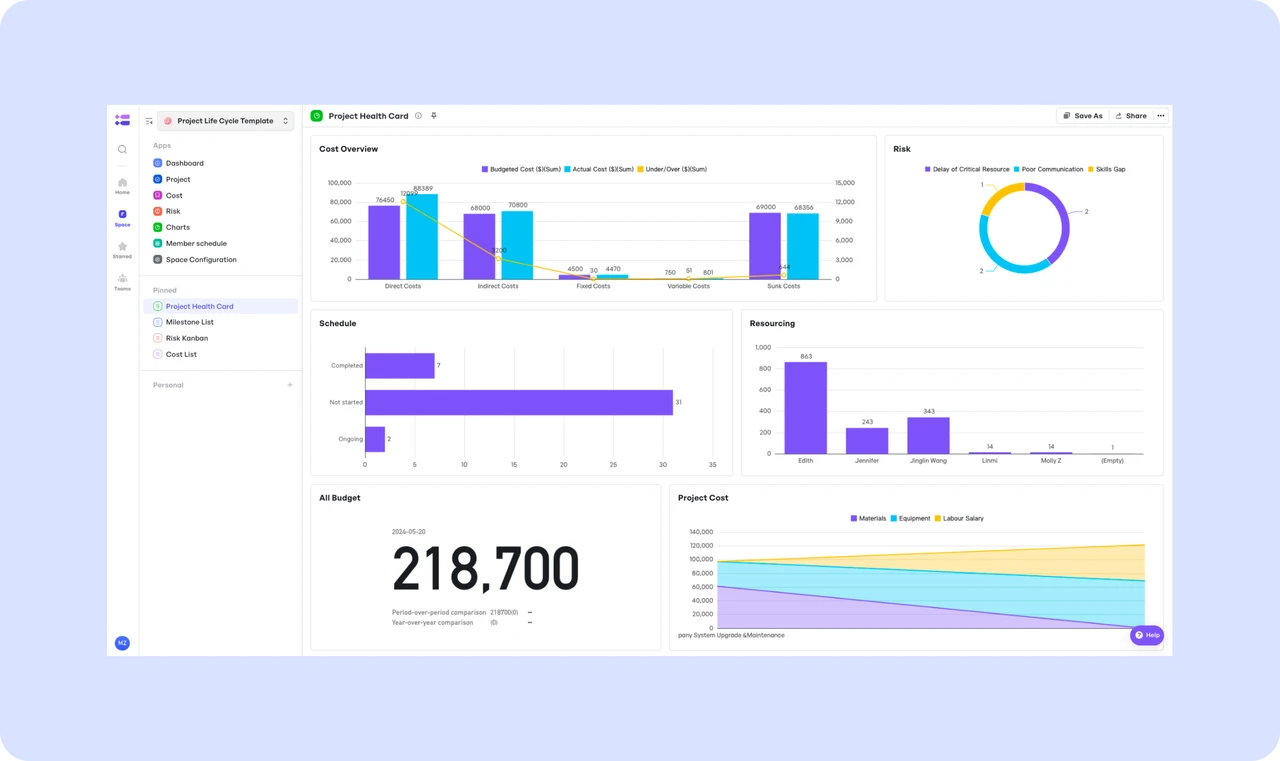 Track milestones and project risks with Meegle charts
Track milestones and project risks with Meegle chartsThe result? Your strategy stays visible. Execution stays focused. And your product stays aligned with business outcomes.
👉 Ready to turn your charter into a plan?
Create clear, actionable product charters faster with Meegle’s structured planning tools.
FAQs
1. Who actually writes the product charter?
While the product manager often owns it at the planning phase, the charter is best written collaboratively—with input from sponsors, design, engineering, and other key stakeholders.
2. What if priorities shift after the charter is approved?
That's okay. You can revise the charter—just make sure updates are documented, shared with stakeholders, and re-approved if they affect scope, goals, or timelines.
3. How detailed should my first charter be?
Start simple—using our product charter template. Aim for clarity over perfection. You can evolve it over time as the project matures, have more key metrics, and more inputs become available.
The world’s #1 visualized project management tool
Powered by the next gen visual workflow engineRead More
Check All BlogsStart creating impactful work today
